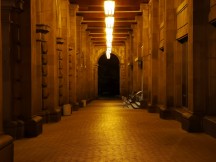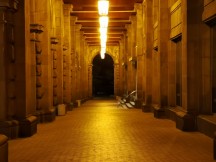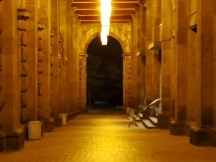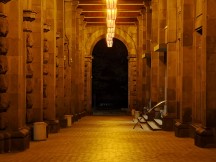Huawei Mate Xs review

Video recording
The Huawei Mate Xs can capture video at up to 2160p with all of its cameras. That includes the main one, ultrawide and telephoto. Beyond that, there is also complete freedom in selecting between 30fps and 60fps. It should be noted that the telephoto can not do 60fps natively, so this mode simply crops from the main camera and doesn't look particularly nice.
Zooming in video can go up to 5x, with all of the small increments in-between. There is plenty of interpolation and cropping going on at most zoom levels, though. Being able to adjust the zoom level while recording is also nice.

As far as notable omissions go, these include no 8K resolution and no high frame rate options, beyond 60fps. Also, while Huawei's EIS efforts deserve plenty of praise, it would be nice to be able to disable stabilization for specific use cases.
Starting with the main 40MP camera, we get very competent, flagship-level video capture. The detail is plenty, everything looks uniform and sharp edge to edge, dynamic range is also great.
The only real criticism we have for the 4K, 30fps clips from the Mate Xs is the slightly muted color tones. Again, this will mostly come down to personal preference, but it is still worth pointing out.
Like we already mentioned, 4K@60fps is the cap for the Mate Xs, both in terms of resolution and bitrate. The company boasts of including eight million aerospace-grade microcapsules around the phone's cameras, which absorb heat through phase transition.
Flipping over to 60fps on the main camera, we did notice some odd behavior. For context, we recorded both this and the previous video at 4K in h.264 mode, in order to get the least possible amount of compression. Both clips have an AVC video stream, alongside a stereo AAC audio one, inside an MP4 envelope. So far, pretty standard. Looking at the video bitrate, though, we see the 30fps clip hovering around 40Mbps, while the 60fps one brings the data rate down to 30Mbps.
While it is fairly common for phones to keep a constant bitrate regardless of framerate and loose quality, this is a case of actually having less bitrate with the higher framerates. To be fair, though, in real-world terms, the 60fps footage doesn't look noticeably worse than the 30fps one. There does seem to be a bit of choppiness in moving objects. Though, not much. Perhaps, Huawei has some variable bitrate trickery going on to save on space.
Dropping the resolution down to FullHD still results is what we would consider flagship-grade performance. There is hardly any difference in procession and we appreciate the consistency. The wonkiness in bitrate between 30 and 60fps is still present, though. We'll stick to 30fps for the other tests, to ensure the best possible quality.
Only the telephoto camera, out of all the snappers on the Mate Xs, has OIS hardware. There is, however, AIS, or Huawei AI Image stabilization working across the board and it performs great.
Once again, one of the few gripes we have with it is the inability to turn it off and potentially get a larger chunk of the sensor as a usable area in the frame.
Before we move on to ultrawide and telephoto video, there is definitely something to be said about the potential on the Mate Xs as a vlogging machine. It leverages its main camera setup to pull-off amazing selfie videos. Clips reap all the benefits we already mentioned from the main camera video capture. Stabilization is also great to have, especially if you plan on walking while recording.
We still don't understand why Huawei decided to disable the ultrawide in "selfie" mode. Maybe we are failing to see some consideration here. It is also worth noting that you have to hold the phone fairly far away from your face to bet a comfortable amount of breathing space around your face in the frame. Of course, if you prefer a more up-close and personal shot, that can easily be achieved, since you don't have to worry about a fixed focal plane.
Ultrawide videos from the 16MP camera on the Mate Xs hold-up pretty well. Compared to clips from the main camera, you are understandably losing some detail and a bit of sharpness. Especially around the corners. Dynamic range isn't nearly as wide, either.
The difference between the two, however, really isn't striking. The ultrawide even manages to get very similar color rendition. Though, perhaps, with just a bit more-muted tone all around. It is kind of hard to tell, due to the cloudy conditions.
Dropping the resolution down to FullHD on the ultrawide still produces what we would consider adequate results. Though, definitely a lot less impressive than the 4K ones. We really don't see a reason to push the quality down deliberately in this manner.
We have literally no complaints with stabilization on ultrawide video. It works and looks great.
The 8MP telephoto camera on the Mate Xs is plagued by some issues. We complained about some of its tendencies to focus-hunt in the photo session, potentially linking them to the OIS hardware. The autofocus issue is even more apparent in video capture. On top of that, circling back to a certain photo issue, we described with the 40MP camera, not keeping its white balance in check, the telephoto seems to be experiencing something similar. Though, in this case, it seems to be the ISO that is elevating and lowering at random. We get that cloudy conditions aren't ideal, but this is a bit too much misbehavior for us not to mention.
Otherwise, 3x zoom videos, which should be the native zoom level for the telephoto camera, look great. Detail is plenty and even dynamic range is satisfactory. Tapping on the viewfinder to get a spot exposure reading did seem to help with the misbehaving random self-adjustment, most of the time.
5x zoom videos are still usable. Though, you won't really be getting a whole lot of extra resolution to make out distant texts, or anything of the sorts. Videos go up to 30x, with everything beyond 5x not claiming to be hybrid in any way. So, you end up with a digitally zoomed image which looks the part. Huawei does what it can to sharpen it, without introducing too much noise, but it's mostly a futile balancing act to begin with.
The always-on Huawei Ai stabilization works surprisingly well in 3x zoom video mode. Beyond that, at 5x, higher and especially noticeably at 30x, the OIS, zoom, and stabilization don't really play nicely together all the time.
It seems that in its efforts to remain as steady and "floaty" as possible, the software makes some assumptions that you won't be changing the frame and shaking too much, trying its best to pad the zoom around a given portion of the image, which is already stabilized. If you shake or pan a bit too much, this tends to result in a noticeable jitter, almost like an aggressive "re-aligning" and "snapping" of the frame. We are definitely overanalyzing it and it's much easier to just see it for yourself. Definitely a noticeable artifact, but hardly a show-stopper.
Finally, here is the Mate Xs in our extensive video compare database.



2160p: Huawei Mate Xs against the Samsung Galaxy Fold and the Huawei P40 Pro in our Video compare tool
Low-light image quality
Huawei's current all-round photography prowess was not achieved overnight. This works well in our favor with the Mate Xs, since even without the company's current-gen camera hardware, it can still flex some impressive results. Low-light photography, in particular, has been an area of dominance for the Chinese giant for a few generations of phones now.




Huawei Mate Xs dusk camera samples




Huawei Mate Xs dusk camera samples
We're kicking things off with a couple of scenes, shot at dusk, complete with all the dramatic skies and intriguing reflections a social network might deem desirable.
We have shots from the ultrawide, main camera, telephoto at its native 3x, as well as a 5x zoom. Supplementing the set with one done under the same conditions, with the same camera and Master AI mode turned on.




Huawei Mate Xs dusk Master AI ON camera samples




Huawei Mate Xs dusk Master AI ON camera samples
Just like before, we are happy to see that the mode generally improves overall quality, clearing-up some softness in the frame, a bit of noise and generally sharpening things a bit. All without noticeably increasing the time necessary to capture a shot.
One less than flattering observation we feel like we have to make about Huawei's camera software, as experienced on our Mate Xs review unit, is that it rarely gave us the confidence to go for a "one shot" approach. Especially in less than ideal conditions.
We already discussed some of the inconsistencies with exposure we experienced in various situations and these tend to only get worse after dark. Don't get us wrong, it's never a bad idea to double-up on your shots and take extra care that things are in focus, but it can be a little too much of a chore for some. We would definitely like to see shot consistency get improved in future camera updates.




Huawei Mate Xs Night mode camera samples




Huawei Mate Xs Night mode camera samples
Of course, there is the distinct possibility for the user to single-handedly ruining shots by applying a too "hand-on" approach. Just check the above set of Night mode shots we took at dusk, when the conditions didn't really call for the feature. Since we had purposefully navigated to it in the camera app, the Mate Xs simply obliged and gave us HDR-stacking and shooting times of up to 6 seconds, so it can properly do what we ask of it and ruing the shots. Joking and deliberate misuse aside, there is more actual criticism to give to the Night mode, so read on.
Before we get to that, though, here is a set of low-light photos, as captured by the main camera on the Mate Xs in its default and intended 10MP mode.






Huawei Mate Xs main camera 10MP samples
These look really impressive. Detail is there, so is dynamic range. Shadows and highlights are well balanced. Colors look great, as well. Just like in good light - a perfect example of really mature camera processing, improved generation after generation.






Huawei Mate Xs main camera 10MP Master AI ON samples
Master Ai only seems to make things better, yet again. The consistency between shots seems to really be the one big issue with the Huawei Mate Xs' camera, overall. When things fall into place and work as intended, the results are really impressive.
Since we are already on the topic of generational improvement and before we move on to Night Mode shots, we should mention that things have clearly changed on the software side, compared to Huawei P30, and its very similar camera setup. That's also a major point in Huawei's press materials - that you might be getting slightly older hardware with the Mate Xs, but one that has been made better with the latest generation of camera software.

We can definitely see signs of this change. Looking back at some low-light shots, we can often spot the main 40MP camera working at ISO levels in the 2000 to 2500 range. The Mate Xs, on the other hand, rarely pushed 1500 in our test scenes. Sure, there was plenty of artificial lighting around.
But, still, that's a noticeable difference and one that suggests Huawei has pushed its default HDR algorithms and computational photography so far that it can pull-off impressive end results with more shots, with shorter exposure and likely less noise to deal with, in the process.
We are making certain assumptions here. Most notably - assuming that the ISO numbers, reported in the EXIF of the final photos are representative, in any way, of what is going on behind the scenes and the actual shots that go into producing the final one. There is, however, further proof of Huawei's generational software improvement to point out by simply analyzing Night mode shots.






Huawei Mate Xs Night mode camera samples
Taking these is a laborious process, requiring a switch to the dedicated mode and then waiting for upwards of 7 seconds, without moving as much as possible, as all the shots get taken ad stacked. You do get to see a real-time preview of the stacking process, which is definitely fascinating, but not really enough to keep your attention and make you forget just how long the process takes after 10, or so, shots.
Don't get us wrong, we don't really mind waiting for good things to happen, but that's just the thing. Unless we are talking about really, really dark scenes, we can't say that the Night Mode shots come out looking any better than the regular ones. Especially with Master AI turned on. Of course, this will very much be on a case to case basis. But, we think that, overall, Huawei's default camera algorithms have gone so far that they have mostly outgrown the need for a dedicated, traditional Night mode, in most cases. That's a win in our book.
Before we move on to the ultrawide and telephoto samples, we didn't forget to snap some 40MP photos with the main camera in low-light conditions.






Huawei Mate Xs 40MP camera samples






Huawei Mate Xs 40MP Master AI ON camera samples
One again, this is not the way this sensor is meant to be used and it shows. There are hardly any benefits to be had in terms of extra detail, compared to 10MP shots. All the while, the debayering process tends to really show mathematical weaknesses in low-light. Things like color fringing and random artifacts are fairly common.
Zooming is definitely not ideal in low-light conditions. Even at its native 3x zoom factor, the 8MP telephoto, with its f/2.4 aperture is just too dim for good low-light results.






Huawei Mate Xs zoom 3x camera samples






Huawei Mate Xs zoom 3x Master AI ON camera samples
While still usable for social media purposes, these shots are just a bit too soft for our taste. And things only get worse with 5x zoom.






Huawei Mate Xs zoom 5x camera samples






Huawei Mate Xs zoom 5x Master AI ON camera samples
The same is generally true for the 16MP, f/2.2 ultrawide camera too. Though, it does seem to hold up a bit better and resolve a bit more detail. On the flip side, it tends to favor an underexposed look, when left to decide for itself. Locking a spot exposure is definitely preferable.






Huawei Mate Xs 16MP ultrawide camera samples






Huawei Mate Xs 16MP ultrawide Master AI ON camera samples
The thing that can really save both zoom and ultrawide shots is Night mode.






Huawei Mate Xs zoom 3x Night Mode camera sample






Huawei Mate Xs zoom 5x Night Mode camera sample






Huawei Mate Xs 16MP ultrawide Night Mode camera sample
These are still scenarios that can really benefit from the extra patience and attention required to get a good stack of several shots. We can clearly see the Mate Xs is doing a solid job of that.
Finally, to cap the low-light section off, we have a couple of videos from the Mate Xs.
Frankly, we didn't have any doubt that the main 40MP camera would hold its own and produce great results. The surprisingly usable ultrawide footage, we got, however, was more of a pleasant bonus worth noting.
Reader comments
- Benetiq
- 18 Mar 2024
- SvB
Bought it in 2024, wonder why. First i had huawei p30 pro, them i Swiched from xiaomi 13 pro and realisez it's snapdragon that's consumin a lot of energy and wasting and heating.
- YUKI93
- 25 Oct 2021
- K1x
I can't help but think that LG or any other brand can use this phone as an inspiration for their rollable screen smartphone. I mean, the camera and the power+volume button is placed on one side with no bezel or notch or even punch-hole interrupt...
- PhomeGeek78
- 27 Mar 2021
- j}d
It comes with a pre installed screen protector. I've had mine 9 months it's still on there.